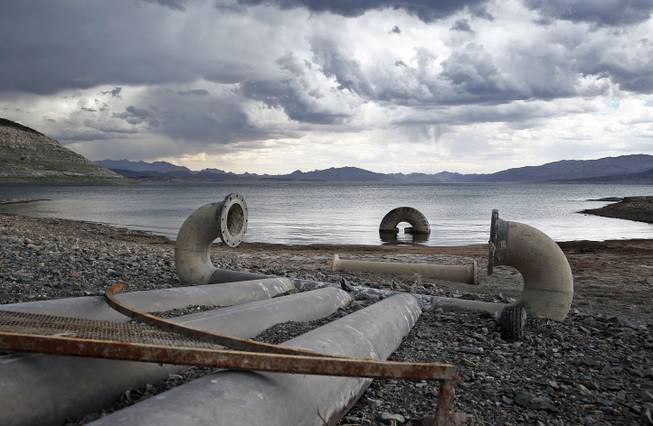
John Locher / AP
Water intake pipes that were once underwater sit above the water line along Lake Mead in Lake Mead National Recreation Area on Monday, May 18, 2015, near Boulder City.
Tuesday, Sept. 29, 2015 | 2 a.m.
CARSON CITY — Plenty of big ideas — and big challenges — have emerged as a panel of water experts crafts a list of action steps for dealing with Nevada's drought.
The Nevada Drought Forum, which Gov. Brian Sandoval created in April, met Monday on the heels of a three-day state drought summit last week. The group plans to ask Sandoval for an extension of a Nov. 1 deadline, and it scheduled two more meetings to finish its work on the report.
A few possible drought solutions the forum is discussing, and the challenges that could come up with each one:
POSSIBLE SOLUTION: DESALINATION
The Southern Nevada Water Authority said it's invested money in exploring how to desalinate ocean water and turn it into drinking water rather than relying so heavily on the Colorado River supply in Lake Mead.
BARRIERS: BUDGETS AND BRINE
SNWA General Manager John Entsminger said the Las Vegas area wouldn't need the additional supply for another 10 to 15 years, and ratepayers wouldn't be interested in coughing up the additional money to pay for multibillion-dollar desalination plants until they're necessary.
He also said there are concerns about where to dump the salt that's removed from the seawater — putting it back in the ocean or disposing of it on land could potentially hurt the environment.
• • •
POSSIBLE SOLUTION: WATER METERING
State officials say they'd be able to better manage Nevada's scarce water resources, and pinpoint waste and leaks, if all water use was tracked with meters.
BARRIERS: PRIVACY CONCERNS
State water engineer Jason King said residents often bristle at the idea of more metering because they don't want the government to have more information about their habits. He said farmers can be especially sensitive about the state tracking their water use, because they fear the state would use that information to cut back their water allotments.
• • •
POSSIBLE SOLUTION: EFFICIENT CROPS
Agriculture officials say some Nevada farmers have already switched from water-guzzling crops to more drought-resistant, higher-yield crops more suited to the desert.
BARRIERS: TOUGH TRANSITION
Panelists say farmers can have trouble transitioning to different crops because they have to learn how to market their new product. It can also be tough to transport specialty crops to buyers, although agriculture officials said northern Nevada products could be shipped to Las Vegas and still marketed under the coveted "locally grown" label.
• • •
POSSIBLE SOLUTION: CLOUD SEEDING
A technology known as cloud-seeding can coax clouds into giving up more of their rain. The process involves shooting a substance such as silver iodide into clouds, allowing moisture to concentrate around the particles and more easily form raindrops.
BARRIERS: LACK OF CLOUDS
The process of cloud-seeding doesn't work if there aren't clouds. The high pressure that causes drought in the first place can edge out even scant cloud cover and frustrate efforts to make it rain.
• • •
POSSIBLE SOLUTION: EDUCATING KIDS
Drought forum panelists say educating children about wise water practices could raise the next generation of good stewards and problem-solvers.
BARRIERS: ILL-FITTING CURRICULUM
Panelists say that while there's no shortage of teaching materials about the water cycle, some of it is developed in rainy climates that look nothing like Nevada's. They say it can be hard for children to relate to lessons not tailored to desert-dwellers.

Join the Discussion:
Check this out for a full explanation of our conversion to the LiveFyre commenting system and instructions on how to sign up for an account.
Full comments policy